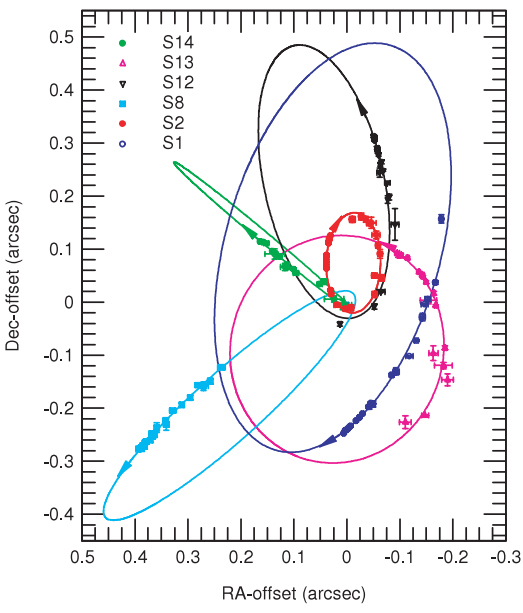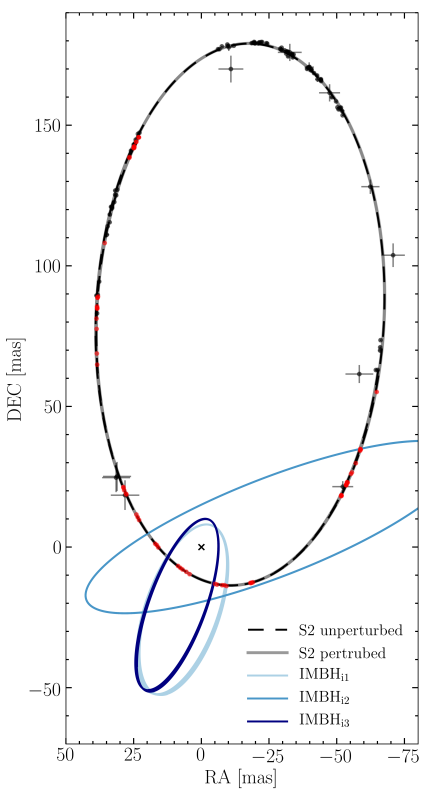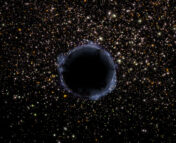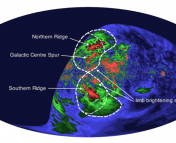Authors: The GRAVITY Collaboration: O. Straub et al.
First Author’s Institution: Max Planck Institute for Extraterrestrial Physics, Giessenbachstraße 1, 85748 Garching, Germany
Status: Accepted to A&A [open access]
Churning away at the center of our galaxy, the supermassive black hole known as Sagittarius A* – a bright source of radio emission – recently made headlines in 2022, when scientists at the Event Horizon Telescope revealed the first direct image evidence of its existence (and the second ever image of a black hole, following the famous picture of M87’s core in 2019). Supermassive black holes are believed to exist at the center of almost every large galaxy, and our galaxy is no exception. Were one to look towards the center of the Milky Way, however, you’d find not an empty space where the black hole has consumed all the matter around it, but a bright galactic core teeming with stars and dust.
Sag A* coexists with a large nuclear star cluster, and about 10 million stars orbit the galactic center within 1 parsec (or 3.26 light years) of it. These stars can and have been individually resolved: most of these stars are old and evolved stars, such as red giants. However, in the innermost region of the cluster (within 0.5 parsecs of Sag A*) there exists a population of younger, less massive, and fast-moving stars, known as ‘S-stars’. The age and location of these stars are both fascinating and puzzling. Firstly, the distribution of their orbits appears to have reached a state in which an equal or similar amount of energy is associated with each star. We call this state “thermal equilibrium” or “relaxation”, and is expected to result after each star has exchanged energy with the other stars of its cluster many, many times due to gravitational interactions. The issue is that the S-stars are so young that it seems unlikely they would already be thermally relaxed this close to Sag A*. Furthermore, should the cluster be relaxed, one would expect the more massive stars to be located closer to the center, with the smaller S-stars further out, which is the opposite of what is observed.
Many theories and models have been proposed to explain the observed properties of the S-star orbits, several of which require the existence of intermediate-mass black holes within the galactic center; objects which could exist there but have not been directly observed. In today’s paper, the authors (collaborators of the GRAVITY instrument) use long-term interferometric observations of the galaxy’s nuclear star cluster – and in particular, one bright and well-known S-star called ‘S2’ – to attempt to constrain the properties, orbit, and existence of IMBHs in the galactic center and thus shed light on the mystery of the S-stars.
Black Holes of Unusual Size
While in theory black holes (BHs) can have practically any amount of mass, in practice we see two distinct kinds: stellar BHs of masses between 3-100 solar masses, formed by the collapse of massive stars, and massive/supermassive BHs of >106 solar masses, thought to form via the collapse of huge gas clouds during the formation of large galaxies. Intermediate-mass BHs (IMBHs), should they exist, would breach the gap between these two types of BHs, and would form through different processes, and are expected to be found in the centers of dwarf galaxies or within star clusters. Several candidate IMBHs have been proposed, including within our galaxy. Should an IMBH exist within the galactic center, it could have dragged the S-stars inwards from a further, more formation/relaxation-friendly distance, for example, though not all S-star theories require an IMBH to exist at all.
To constrain the mass and location of such an IMBH, the authors looked at data from several of the brightest S-stars, including in particular a star known as S2 (see Figure 1). Combining interferometric observations taken from instruments at the VLT, Keck, and Gemini observatories, the authors were able to reconstruct the orbit and motion of S2 from 1992 until today, in order to create a model of its highly-elliptical orbit around Sag A*. Then, they simulated a three-body problem for a hypothetical Sag A* – IMBH – S2 system, allowing the mass and orbit parameters for both S2 and the IMBH to fluctuate over a wide range of values, and compared the results of their simulation with the observations.

The authors tested two scenarios separately. In the first (“hierarchical”) case, Sag A* and the IMBH would act as a close binary, with S2 orbiting them both. In the second (“non-hierarchical”) case, the orbit of the IMBH was allowed to either cross or be fully outside the orbit of S2 around Sag A*.
For the hierarchical case, they found that an IMBH with a mass >4000 solar masses most likely could not exist within the orbit of S2, and at smaller orbits, even masses >2000 solar masses were very strongly excluded, as such an object in such an orbit would have strongly disrupted the observed orbit of S2. As such, an IMBH in this orbit, while possible, is not super likely.
For the non-hierarchical case, due to the chaotic nature of the three-body problem and the resolution of the current data, specific combinations of masses and orbital properties exist as valid solutions for IMBHs with the data given.
Unstable Elements
In order to understand the long-term effects such an IMBH would have on the entire population of S-stars, the authors then proceeded to extract 60 random valid IMBH solutions from each of the two scenarios, placed them among a system of 40 observed S-stars (not just S2), and ran the simulation forward in time by one million years. This time, they were not looking to have the parameters of the IMBH vary and explore the space of solutions, but simply to see how such IMBHs would affect the orbits and population of S-stars around the galactic center.
What they found was that all of their previously-valid IMBH solutions introduced enough instability in the system such that the orbits of the S-stars varied wildly from the non-IMBH case, and that the majority of solutions caused several stars to become unbound and ejected well before a million years had passed. As a result, the current stability of the S-star cluster turned out to be a stronger constraint for the properties of a hypothetical IMBH than the S2 orbit alone was.
In the end, only four non-disruptive solutions for the IMBH were found. Three of them had orbits crossing the orbit of S2, were below 2000 solar masses in mass, and had high orbital eccentricity. Those three allowed IMBH orbits are shown in Figure 2. The fourth was the only solution whose orbit was completely outside S2s, and had a mass of ~3200 solar masses.

As a result, the authors conclude that the existence of an IMBH among the S-stars, while not fully prohibited by the data, is highly unlikely. If one does exist, it has to be of low mass and on a short and eccentric orbit; once the GRAVITY instrument is able to observe a full orbit of S2 (by 2034), much stronger constraints can be placed on IMBH properties. These results have strong implications for the validity of theories for the current age and location of the S-star cluster, as well as constraining theories for the formation and evolution of IMBHs themselves.
Astrobite edited by Katya Gozman
Featured image credit: NASA/ESA/STScI/JWST




